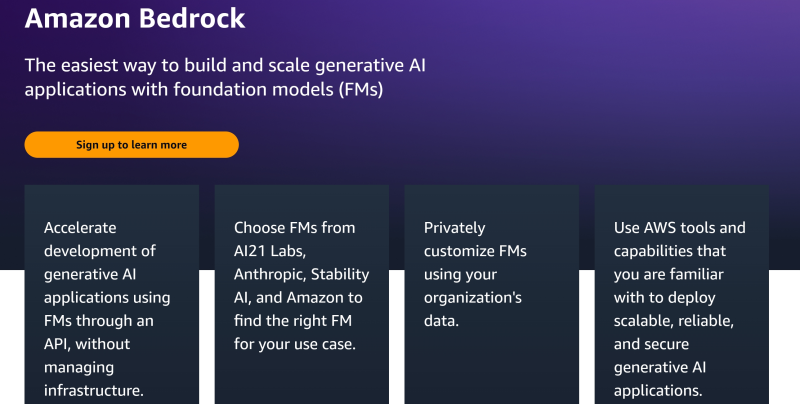Amazon Bedrock could be your next go-to platform if you want to build generative AI-based applications because of its amazing capabilities and the strength of AWS.
It will also be of huge help to companies and individuals who look forward to utilizing generative AI and ML in their workflow and producing high-quality images and content pieces, and providing a better customer experience.
According to Gartner’s prediction, generative AI will be automating 60% of all design efforts for mobile applications and websites by 2026.
So, generative AI systems like Amazon Bedrock have a lot of scope and potential across many sectors, and the usage is expected to grow more.
In this article, I’ll talk about generative AI and Amazon Bedrock and how they can help you.
Let’s start!
What Is Generative AI?

Generative Artificial Intelligence (Generative AI) is an AI type that can generate images, text, and other media as a response to a prompt.
When used in a system and trained on a given dataset, it can help you create realistic images, stories, music, videos, conversations, etc. Generative AI models study the input training data’s structure and patterns to generate fresh data with similar characteristics.
Large, pre-trained ML models are used to power generative AI. These ML models are called Foundation Models (FMs) or base models. ML models can have millions and billions of variables or parameters.
A large number of parameters make FMs capable of grasping complex concepts. If you train them on large data sets with different patterns and forms, FMs can apply the learnings in various contexts.
FMs can perform a variety of tasks, from writing a blog and generating images to answering questions and solving mathematics problems. Given the general-purpose nature and size of FMs, they are different from traditional ML models that can perform specific tasks only like text analysis, image classification, predictions, etc.
Some of the prominent generative AI systems are Open AI’s ChatGPT, Bing Chat, Google’s Bard, and more, including DALL-E, Stable Diffusion, and Midjourney.
Applications of Generative AI

Some applications of generative AI are:
- Software development: Creating generative AI-based applications that can perform several tasks. You can also use it for code generation, verification, and explanation.
- Writing: You can use generative AI systems to write articles, email responses, resumes, social media profiles, etc. You can also create summaries of a content piece and simply the content by breaking down its title, extracting key elements, and creating outlines.
- Art: Generative AI-based systems can help you generate artistic images, pictures, and scenes that you can use in a variety of areas, be it articles, films, games, videos, etc. You can also create music in the desired time and style.
- Product design: You can create your product’s models in 2D and 3D to see how it looks. This will enable you to perform effective A/B testing to pick the better design based on your use case.
- Finance: You can create FinTech applications with great computing power and modern capabilities. These apps will be scalable, secure, and reliable.
- Healthcare: You can create medical images showing how a disease develops in the future. This will enable you to provide better treatments and prevention plans and test drugs.
- Marketing: Marketing teams can generate useful press releases, articles, ad campaigns, emails, etc., using generative AI apps.
- Customer support: You can provide effective customer support through advanced chatbots.
Advantages of Generative AI

- Automation: Generative AI models help automate various tasks that are time-taking and tedious, like responding to emails, answering similar questions, monitoring, etc.
- Improved responses: Compared to traditional AI systems, generative AI systems provide relevant, precise, and correct answers. Thus, it improves your responses and helps provide better customer experiences.
- Realistic experiences: By generating photorealistic images and graphics, you can use them in different areas of your business, from articles and other resources to products and services.
- Simplified content creation: Generative AI makes content generation simple and quick instead of hours.
- Faster product development: By automating tasks, streamlining content creation, and using scalable and performing applications, you can develop products faster.
Prepare Data for Generative AI
Preparing data for generative AI requires careful planning and gathering of a large volume of data for training your model. For this, ensure:
- Data is of high quality; it must be relevant, complete, accurate, and bias-free
- To collect both unstructured and structured data from multiple sources like emails, databases, and other documents
- Data is labeled and stored in CSV, JSON, TFRecord, etc.
- Data is cleaned by removing inaccurate, incomplete, and corrupted data
- To perform data preprocessing with techniques like normalization and formatting
Best Practices for Implementing Generative AI

Ensuring AI transparency and trust is important, so follow these best practices:
- Conduct extensive testing internally with many use cases before you use generative AI for producing content for end users
- Uphold transparency with your customers and employees when they interact with a machine with proper labeling.
- Set up guidelines and processes to detect and remove biases. Validate results and test continuously.
- Address security and data privacy concerns by protecting sensitive data
- Release your generative AI in beta at first to gauge user experience and seek feedback to improve.
Challenges in Generative AI Implementation
- There is no easy way to find high-performing FMs and access them that are suitable for their use case and can provide great results.
- Organizations find integration into apps difficult as they have to incur heavy costs and manage huge infrastructure.
- It’s hard for them to use the base FM to develop various apps with their data.
- Customization could also be a hurdle.
- Concerns regarding data privacy and security.
Amazon paid attention to these challenges and came up with Bedrock which aims to solve these problems. Here’s how.
What Is Amazon Bedrock?

Amazon Bedrock is a fully-managed service that provides an easier way to develop generative AI apps and scale them with foundation models (FM).
This tool can enable you to make available FMs from Amazon and top AI startups through an API. As a result, you will have many options of FMs to choose from and find the best suitable model for your needs. These options include FMs from Amazon, Anthropic, Stability AI, and AI21 Labs.
Bedrock will give you a truly serverless experience to help you quickly get started and customize FMs using your data privately. It will become easier for you to integrate and deploy secure, reliable, and scalable FMs into your apps with the help of AWS capabilities and tools you use without managing any infrastructure. This accelerates generative AI app development.
Features and Capabilities of Amazon Bedrock
#1. A Wide Variety of FMs
Amazon Bedrock customers will get a wide variety of FMs that are advanced and easily accessible. This includes:
- Claude: Anthropic’s LLM that can perform numerous text processing and conversational tasks. It’s based on the extensive research of Anthropic into training responsible and honest AI systems.
- Jurassic-2: The multilingual Jurassic-2 LLMs from AI21 Labs use natural language commands to generate unique text in German, French, Spanish, Italian, Dutch, and Portuguese.
- Stable Diffusion: You can easily access many text-to-image FMs by Stability AI, including Stable Diffusion. These FMs can generate realistic, high-quality, and unique designs, logos, art, and images.
- Amazon Titan: Bedrock will allow you to access many powerful FMs by Amazon Titan to create images and text. It will have two newly created LLMs to make the user experience much more interesting.
By choosing your preferred FMs from this list, you can get started with your project quickly, whether it’s app development or image and text generation.
#2. Titan FMs
Amazon has been previewing its latest Titan FMs with some customers before making them available broadly. They have two Titan FMs initially:
- Generative LLM: It’s for tasks like text generation, text summarization, open-ended Q&As, information extraction, and classification.
- Embeddings LLM: It can translate text inputs like large text units, phrases, words, etc., into embeddings or numerical representations containing the text’s semantic meaning.
Although LLM won’t generate text, it’s used in many applications such as search, personalization, etc. The reason is that comparing embeddings enables models to produce more contextual and relevant responses than that just word matching. It also makes finding products easier and quicker.
#3. Customization

Amazon Bedrock provides a high level of customization. It’s effortless to customize a given AI model with your data to make it suitable for your project.
You simply need to point Bedrock at some labeled examples in S3 to let it fine-tune your model for your specific use case. Even 20 labeled examples are also enough to get the stuff done. This will eliminate the need for annotating large data volumes and save you plenty of time and effort.
Example: Suppose you are a content marketer working at a cloth brand. You want to create a campaign copy to attract potential buyers toward an upcoming line of shirts.
For this, you can provide Amazon Bedrock with some labeled examples of your best-performing campaign copies and descriptions from the past. Next, Bedrock will create a separate, private copy of the foundation model that customers can only access and then train this model. It will then automatically generate effective campaign copy for new shirts.
#4. Security and Privacy

For training the base models, Amazon Bedrock never uses customer data. In addition, it encrypts all data and never leaves a Virtual Private Cloud (VPC) of a customer. This way, Amazon Bedrock strives to maintain customer trust. So customers can stay assured that their data is secure and confidential.
Furthermore, Amazon’s Titan FMs are designed in such a way that it becomes quicker to detect harmful data and remove it. It can also find out inappropriate content in a user’s input and reject it. In addition, it can filter the AI model’s output containing inappropriate content like violence, profanity, hate speech, etc.
#5. Accessibility
Amazon Bedrock facilitates greater accessibility of FMs to businesses of all shapes and sizes, whether you are a startup, small business, mid-sized business, or enterprise. You will be capable of experiencing the power of FMs throughout your organization. You can accelerate ML usage and empower your developers to easily build generative AI apps of your own.
Companies like Infosys, Accenture, Deloitte, etc., are developing practices to assist companies in moving faster in generative AI usage.
#6. Scalability
With AWS, users can have a more reliable and scalable experience developing modern AI applications. You can easily integrate your chosen and customized FMs into scalable applications and deploy them faster with the help of capabilities and tools that AWS offers and that you use.
This will eliminate the need to manage any infrastructure. For example, you don’t have to manage integrations with SageMaker ML functionalities (such as Experiments) to test various models, Pipelines to handle FMs at scale, and so on.
If your data is stored on AWS already, it will become easier to scale your data and use generative AI with Bedrock with greater privacy and security.
Integrations

Amazon Bedrock integrates with many software tools and services:
- Amazon Web Services (AWS) for database storage, compute power, content delivery, and more
- Anthropic’s Claude AI to generate and process human-like text
- Stability AI to design and implement solutions using augmented technology and collective intelligence
- Stable Diffusion to produce realistic images
- Amazon Titan to make FMs accessible via an API
Use Cases of Amazon Bedrock

Chatbots
With Amazon Bedrock, you can develop conversational user interfaces like virtual assistants and chatbots. These applications can help enhance customer experience by helping them answer their queries, find what they are looking for in your website, and more.
Text Generation
Amazon Bedrock will help you create original content, including essays, webpage copy, social media posts, and short stories. With Amazon Bedrock, you can generate text for your content pieces. Thus, you won’t be lagged due to any reason, whether it’s grammar, word power, or anything else. You can create content easily and publish it wherever you want.
Personalization
Modern customers love personalized services instead of vague, irrelevant products and services that kill their time and patience.
With Amazon Bedrock, you will be able to provide personalized services and products. It will help your customers find things they are searching for, which helps enhance their experience on your website. The recommendations will be more contextual and relevant compared to word matching.
Text Summarization
AWS Bedrock can provide you with a summary of text-based content like blogs, articles, books, and other documents. This helps you get the gist of a content piece in a short period without having to dedicate hours or days to reading the stuff.
Search

When a customer asks a question, it’s important to give them a prompt reply from available data to ensure a better customer experience.
So, instead of keeping them waiting, you can serve them with relevant and accurate answers with the help of Amazon Bedrock. The tool can search, synthesize, and find the required information out of a large pool of data. This way, you can provide quick replies to customers and help them find what they are looking for.
Image Generation
With Amazon Bedrock’s generative AI platform, you can create artistic and realistic images of objects, subjects, scenes, environments, etc., using language prompts.
This is useful for businesses to create images and add them to their products, services, blogs and articles, catalogs, and other documents. As a result, you can engage your audience more in your offerings and grow your business more.
Support and Training
Currently, Bedrock provides online support to its users. Since it’s by Amazon, you can expect better support and get your queries resolved quickly. Whether you belong to a small, medium, or enterprise business or a freelance, government, or non-profit organization, you will get quality support.
In addition, Bedrock provides documentation for training users.
The Future of Amazon Bedrock
Amazon Bedrock has huge potential and can bring great performance, scalability, and quality to your applications. Amazon announced Bedrock on April 13, 2023. Although this generative AI service is still in limited preview, some of its customers have early access to try the service and give their feedback.
Initially, they are planning to release two Titan FM models – generative LLM and embedded LLM; both are capable of performing a variety of tasks, from generating text, images, etc., to search and personalization.
Bedrock is going to be a big step towards FM democratization, helping companies accelerate ML usage with better reliability, scalability, and performance. Bedrock is expected to be broadly introduced in the upcoming months. Till then, keep a tab on the latest news.
You may also read how generative AI search is changing search engines.

